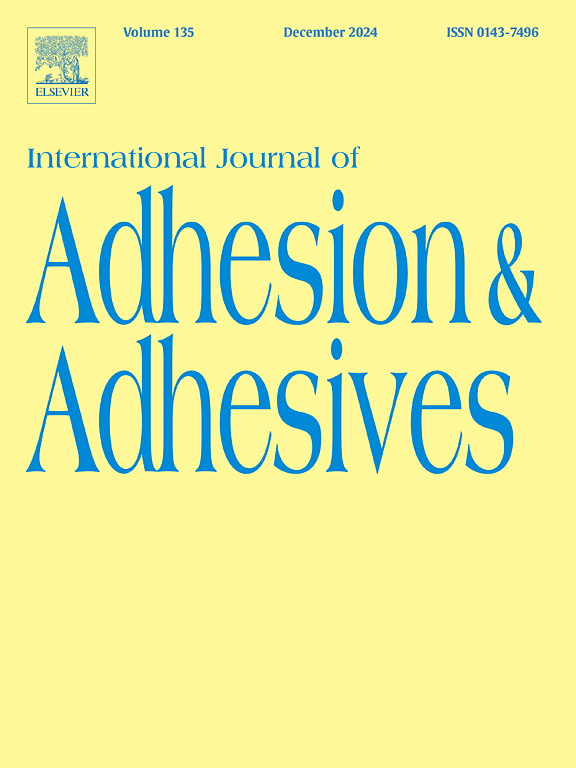表面粗糙度及等离子体处理对铝-聚酰胺粘接接头影响的研究
IF 3.2
3区 材料科学
Q2 ENGINEERING, CHEMICAL
International Journal of Adhesion and Adhesives
Pub Date : 2025-02-05
DOI:10.1016/j.ijadhadh.2025.103964
引用次数: 0
摘要
本研究考察了粗糙度和等离子体处理对粘接铝和聚酰胺样品的影响。表面处理采用砂光和等离子体两种方法,既可以单独处理,也可以联合处理。结果表明,随着表面粗糙度的增加,接触角略有减小,搭接抗剪强度(LSS)略有增加。铝的粗糙度从0.35 μm提高到0.53 μm,提高了51.43%;聚酰胺的粗糙度从0.26 μm提高到0.38 μm,提高了46.15%。这导致LSS增加34.09%(从2.2 MPa增加到2.95 MPa)。然后应用等离子体处理,显著减小了两种材料的接触角并增强了LSS。然而,当治疗双方时,没有观察到这些效应的放大。实验表明,铝和聚酰胺的接触角分别减少了47.88%(从71.77°减少到37.41°)和74.28%(从60.48°减少到15.55°)。仅处理聚酰胺的LSS增加了105.42%(从2.95 MPa增加到6.06 MPa)。通过等离子体处理聚酰胺,将两侧粗糙度提高到50%左右,获得了最佳的LSS。由于等离子体处理,失效机制从基底转移到粘附/内聚。此外,粗糙度的增加促进了粘合失效。本文章由计算机程序翻译,如有差异,请以英文原文为准。
Investigation of the effect of surface roughness and plasma treatment on adhesively bonded aluminium-polyamide hybrid joints
This study investigated the effects of roughness and plasma treatment on adhesive-bonded aluminium and polyamide samples. The surfaces were treated using sanding and plasma methods, both independently and in combination. The results showed a slight decrease in contact angle and an increase in lap shear strength (LSS) with increasing surface roughness. The roughness of aluminium increased by 51.43 % (from 0.35 μm to 0.53 μm) and that of polyamide by 46.15 % (from 0.26 μm to 0.38 μm). This resulted in a 34.09 % increase in LSS (from 2.2 MPa to 2.95 MPa) specifically. Plasma treatment was then applied, which significantly reduced contact angles and enhanced LSS on both materials. However, amplification of these effects was not observed when treating both sides. The experiment showed a decrease in contact angle on aluminium by 47.88 % (from 71.77° to 37.41°) and on polyamide by 74.28 % (from 60.48° to 15.55°). Treating only polyamide resulted in a 105.42 % increase in LSS (from 2.95 MPa to 6.06 MPa). The optimal LSS was achieved by treating polyamide with plasma and increasing the roughness of both sides to around 50 %. The failure mechanism shifted from substrate to adhesion/cohesion due to plasma treatment. Additionally, an increase in roughness promoted adhesion failure.
求助全文
通过发布文献求助,成功后即可免费获取论文全文。
去求助
来源期刊

International Journal of Adhesion and Adhesives
工程技术-材料科学:综合
CiteScore
6.90
自引率
8.80%
发文量
200
审稿时长
8.3 months
期刊介绍:
The International Journal of Adhesion and Adhesives draws together the many aspects of the science and technology of adhesive materials, from fundamental research and development work to industrial applications. Subject areas covered include: interfacial interactions, surface chemistry, methods of testing, accumulation of test data on physical and mechanical properties, environmental effects, new adhesive materials, sealants, design of bonded joints, and manufacturing technology.
 求助内容:
求助内容: 应助结果提醒方式:
应助结果提醒方式:


